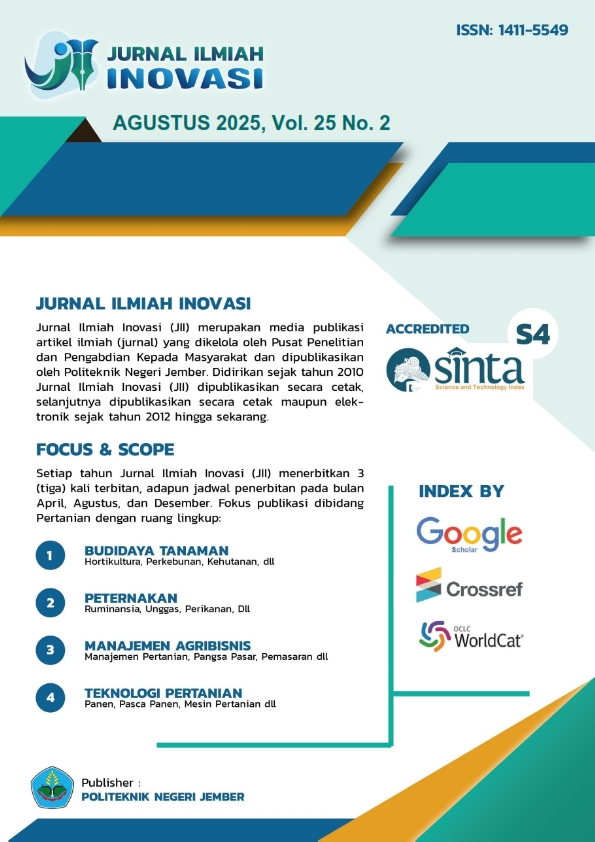Chemical And Microbiological Properties Of Fermented Dragon Fruit Peel Beverages
DOI:
https://doi.org/10.25047/jii.v25i2.6104Keywords:
dragon fruit peel, fermented beverages, lactic acid bacteriaAbstract
Dragon fruit peel is rich in bioactive compounds such as betacyanin, betasianidin, polyphenols, and dietary fiber, which can potentially provide health benefits and added value to food products. This research aimed to determine the best formulation of fermented dragon fruit peel beverages based on chemical and microbiology characteristics. The fermentation process is a method for increasing the availability of nutrients in food, as well as creating new compounds that are beneficial for human health. Currently, there is a growing demand for fermented products originating from non-dairy sources, so research on fermented beverages from dragon fruit peel could be an interesting and sustainable solution in the functional food and beverage industry. Chemical analysis in the research conducted includes analysis of reducing sugar, total titratable acidity, and pH, while microbiological analysis was in the form of total lactic acid bacteria. The factor used in this research was the concentration of dragon fruit peel (20%, 40%, 60% and 80%). The results showed that the best formulation was 40% sugar concentration based on reducing sugar (2,92±0,023%,) total titratable acidity (0,27±0,015%), pH (3,53±0,025), and total lactic acid bacteria (4.8 x 109 CFU/ml)
Downloads
References
[1] AOAC. (1995). Official Methods of Analysis of Association of Official Analytical Chemist. In AOAC International.
[2] AOAC. (2000). Official Methods of Analysis of Association of Official Analytical Chemist. InAOAC International.
[3] Bethany, R.V., Dwiloka, B., Hintono, A. (2024). Effect of Using Red Dragon Fruit Peel Juice on Crude Fiber Content, Shelf Life, and Sensory Characteristics of Wet Noodles. Jurnal Pangan dan Agroindustri, 12(2): 112-123.
[4] Budiari, S., Mulyani, H., Maryati, Y., Filailla E., Devi, A. F., Melanie H. (2023). Chemical properties and antioxidant activity of sweetened red ginger extract fermented with kombucha culture. Jurnal Agrointek, 17(1).
[5] Enjelina, W., Rilza, Y. O., Erda, Z. (2019). Pemanfaatan kulit buah naga merah (Hylocereus polyrhizus sp.) untuk memperpanjang umur simpan mie basah. Aceh Nutrition Journal, 4(1): 63-69.
[6] Gänzle, M. G. (2015). Lactic metabolism revisited: metabolism of lactic acid bacteria in food fermentations and food spoilage. Current Opinion in Food Science, 2, 106-117.
[7] Ginting, S, O,. V. P. Bintoro,. H. Rizqiyati. (2019). Analisis Total BAL, Total Padatan Terlarut, Kadar Alkohol, dan Mutu Hedonik pada Kefir Susu Sapi dengan Variasi Konsentrasi Sari Buah Naga Merah (Hylocereus polyrhizus). Jurnal Teknologi Pangan. 3(1): 104-109
[8] Kim, D.-H., Lee, S.-B., Kim, D.-H., Lee, S.-B., & Park, H.-D. (2018). Fermentation characteristics of campbell early grape wine inoculated with indigenous Korean wine yeasts encapsulated in Ca-alginate beads after air-blast drying. Italian Journal of Food Science, 30, 535–552
[9] Naufal A., Harini, N. and Nuriza Putri, D. (2023). Karakteristik Kimia dan Sensori Minuman Instan Kombucha dari Kulit Buah Naga Merah (Hylocereus polyrhizus) Berdasarkan Konsentrasi Gula dan Lama Fermentasi. Food Technology and Halal Science Journal, 5(2): 137–153.
[10] Prasetya, R,. J, Sumartono, T, Setyawaradani,. M, Tianling. (2022). Total Asam Tertitrasi, pH dan Tekstur Yoghurt Yang Ditambah Ekstrak Beras Hitam dengan Pemberian Hidrokoloid yang Berbeda. Prosiding Seminar Teknologi dan Agribisnis Peternakan IX. Fakultas Peternakan Universitas Jenderal Soedirman, 14 – 15 Juni
[11] Putri, S.A., Restuhadi, F., Rahmayuni. (2016). Hubungan Antara Kadar Gula Reduksi, Jumlah Sel Mikrob dan Etanol Dalam Produksi Bioetanol Dari Fermentasi Air Kelapa Dengan Penambahan Urea. Jom Faperta 3(1).
[12] Rizal, S., F. Nurainy., dan M. Fitriani. (2013). Pengaruh penambahan sari buah jambu biji merah (Psidium guajava L.) dan glukosa terhadap total bakteri asam laktat dan karakteristik organoleptik minuman sinbiotik cincau hijau (Premna oblongifolia Merr). J. Teknol. Industri dan Hasil Pertanian 18 (2): 144-156.
[13] Sagita, C., (2023). Pembuatan minuman probiotik dari limbah kulit nanas (Tepache). Tarbiatuna: Journal of Islamic Education Studies, 3(2), pp.205-210.
[14] Saraswati, D. S., Yusmarini, & Ayu, D. F. (2023). Pemanfaatan ekstrak kulit buah naga merah sebagai pewarna alami minuman probiotik sari buah sirsak. Teknologi Pangan : Media Informasi Dan Komunikasi Ilmiah Teknologi Pertanian, 14(1): 48-58.
[15] Sari, A. R. dan Hardiyanti, R. (2013). Antioxidant Level and Sensory of Dragon Fruit (Hylocereus undatus) Peel Tea Infusion Made by Partially Fermented Process. Agroindustrial Journal, 2(1): 63–68.
Downloads
Published
How to Cite
Issue
Section
License
Copyright (c) 2025 Irene Ratri Andia Sasmita, Putu Tessa Fadhila, Findi Citra Kusumasari, Mohammad Mardiyanto, Emi Kurniawati

This work is licensed under a Creative Commons Attribution 4.0 International License.
Copyright Notice
Authors who publish with this journal agree to the following terms:
- Authors retain copyright and grant the journal right of first publication with the work simultaneously licensed under a Creative Commons Attribution License that allows others to share the work with an acknowledgement of the work's authorship and initial publication in this journal.
- Authors are able to enter into separate, additional contractual arrangements for the non-exclusive distribution of the journal's published version of the work (e.g., post it to an institutional repository or publish it in a book), with an acknowledgement of its initial publication in this journal.
- Authors are permitted and encouraged to post their work online (e.g., in institutional repositories or on their website) prior to and during the submission process, as it can lead to productive exchanges, as well as earlier and greater citation of published work (See The Effect of Open Access).






